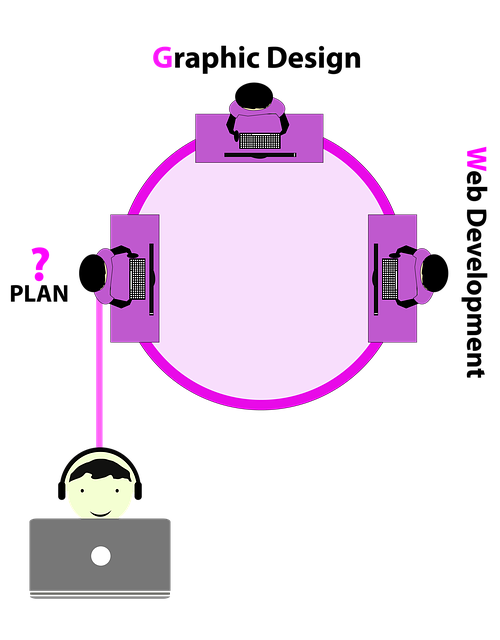Professional branding thrives on more than just logos; it's about how a business presents itself globally, especially in today's digital market. Creative web design is crucial, acting as a strategic narrative tool that engages users and communicates brand identity through captivating visuals and intuitive navigation. This ensures the website reflects the brand's values, leaving lasting impressions of quality and professionalism. A well-designed website, with its emphasis on UX, prioritizes user needs to foster emotional connections, enhance brand recognition, and boost loyalty in a competitive online market. Color palettes and typography are powerful elements that evoke emotions and convey brand messages, while strategic optimization techniques improve search engine visibility and conversions, ultimately strengthening professional branding.
In today’s digital landscape, professional branding and web design are indispensable tools for businesses aiming to thrive. A strong brand identity, crafted through understanding your target audience and unique value proposition, forms the cornerstone of success. Creative web design goes beyond aesthetics; it employs visual storytelling techniques to captivate users, fostering a connection with your brand. This article explores key elements, from user experience optimization to typography choices, and emphasizes the vital role of search engine visibility and conversion rates in achieving online prominence through effective creative web design.
Understanding Professional Branding: The Cornerstone of Success

Professional branding is more than just a logo or color palette; it’s the essence of how a business presents itself to the world. In today’s digital era, where folks navigate labyrinthine markets with swift clicks and scrolls, a strong brand identity acts as a beacon, guiding potential clients and customers towards your door. It’s about crafting a unique story that resonates, creating an indelible impression that sets you apart from competitors in the bustling landscape of online commerce.
At the heart of successful professional branding lies creative web design. Your website is often the first point of contact with clients, making its aesthetics and functionality paramount. A meticulously designed site, enhanced with engaging visuals and intuitive navigation, not only captivates visitors but also conveys your brand’s values and promises. Think of it as a symphony of visual elements that harmonize to create an experience that leaves a lasting impression—a true testament to your brand’s quality and professionalism.
Creative Web Design: A Visual Storytelling Approach

Creative web design goes beyond aesthetics; it’s a visual storytelling approach that captivates users and conveys a brand’s essence. By integrating unique layouts, eye-catching visuals, and compelling typography, designers craft digital narratives that engage audiences from the moment they land on a website. This art form transforms static elements into dynamic experiences, ensuring visitors not only understand but also emotionally connect with the brand’s message.
In today’s digital landscape, creative web design serves as a powerful tool to differentiate brands in a crowded marketplace. It invites users to explore and interact, fostering a sense of curiosity and desirability. Through careful consideration of color palettes, imagery, and animation, designers can create immersive environments that reflect the brand’s personality and resonate with its target audience.
The Impact of User Experience (UX) in Branding

In today’s digital era, user experience (UX) plays a pivotal role in shaping successful professional branding and web design. A well-designed website acts as a mirror to a company’s identity, and an exceptional UX ensures that visitors not only perceive but also deeply engage with that brand. Creative web design isn’t merely about aesthetics; it involves crafting intuitive navigation, seamless interactions, and visually appealing layouts that resonate with the target audience. When users find a website easy to navigate, enjoyable to interact with, and visually compelling, they are more likely to convert into clients or loyal followers.
Branding is not just about logos and slogans; it’s about creating an experience that leaves a lasting impression. A positive UX can significantly enhance brand recognition and loyalty by fostering emotional connections between users and the brand. By prioritizing user needs, preferences, and behaviors in web design, professionals can ensure their online presence effectively communicates the unique value proposition of their business, setting them apart from competitors in a crowded digital landscape.
Choosing the Right Color Palette for Your Brand Identity

In the realm of professional branding and creative web design, selecting the perfect color palette is a game-changer. It’s not merely about aesthetics; colors evoke emotions and convey brand messages. For instance, blues often signify trust and stability, while warm tones like oranges and yellows can represent energy and creativity. A well-thought-out color scheme enhances user experience, making your website visually appealing and memorable.
When crafting a brand identity, consider your target audience and the values you want to convey. Consistently using chosen colors across your web design ensures brand recognition. For a truly captivating creative web design, experiment with complementary hues or opt for a monochromatic theme to create a sophisticated look. This strategic approach will not only elevate your brand’s online presence but also leave a lasting impression on folks navigating your digital landscape.
Typography and Its Role in Effective Communication

Typography plays a pivotal role in effective communication within creative web design. The choice of fonts, letter spacing, and layout can significantly impact how content is perceived by users. Well-selected typography not only enhances readability but also contributes to the overall aesthetic appeal and brand identity of a website. A harmonious blend of typefaces can guide users’ eyes through pages, emphasizing key information and creating a visually engaging experience.
In the realm of professional branding, typography becomes an integral tool for conveying values and personality. Different fonts can evoke various emotions—serifs might suggest tradition and reliability, while sans-serif types offer a modern and clean look. Web designers leverage this versatility to ensure that text supports the brand message and engages users in a meaningful way. Effective typographic choices thus contribute to successful communication and a memorable online presence.
Optimizing Your Website for Search Engines and Conversions

A well-designed website is only half the battle; ensuring your online presence is optimized for search engines and conversions is paramount to professional branding success. Implementing creative web design strategies, such as strategic keyword placement, enhances your site’s visibility on search engine result pages (SERPs). This involves thorough research into relevant industry terms and phrases that potential clients might use when searching for services similar to yours.
By integrating these keywords naturally throughout your content—from page titles and headings to meta descriptions and body text—you increase the likelihood of ranking higher in SERPs. Furthermore, converting visitors into customers requires user-friendly navigation, compelling calls-to-action (CTAs), and a seamless mobile experience. Optimizing for conversions means understanding user behaviour and designing with clear objectives in mind, ensuring every element on your website contributes to guiding visitors towards desired actions, whether that’s making a purchase, subscribing to a newsletter, or requesting a quote.
